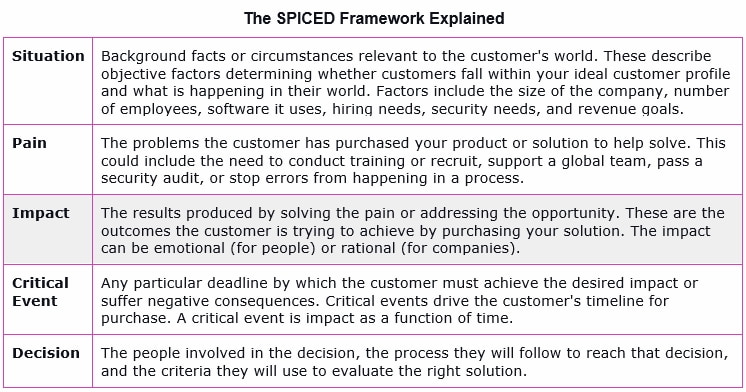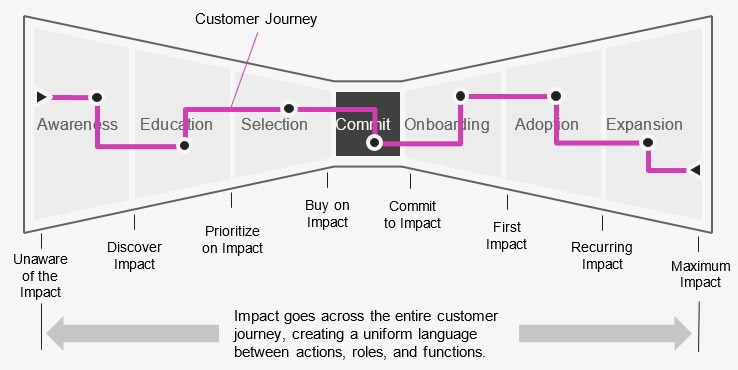In previous articles, we described how SaaS and recurring revenue growth does not operate within the traditional marketing funnel, but a more complex, bow-tie model. We also looked at the effects of recurring rational and emotional impact.
SPICED is a uniform framework based on the fundamental principle that recurring revenue comes from recurring impact. Using SPICED as a framework, you can find and organize information systematically to ensure you understand your prospects' background, pains, desired impact, and how and when they will commit to your solution.

The beauty of the SPICED framework is that it is flexible to meet your customer at the point of impact. It is not a one-time diagnostic tool for lead or deal qualification. It is a framework that applies throughout the customer journey, at each stage of the Bow Tie.
Uses for the SPICED Framework
1. Marketing
Marketing teams can use SPICED to identify their ideal customer profile (ICP), create a value proposition for their website, and provide guidance on SEO terms.
2. Lead Generation and Development
Lead generation teams can use SPICED in their email campaigns, addressing prospective users based on emotional impact and organizing webinars on topics close to decision-makers' hearts.
Note: The order of the letters in which the SPICED acronym is organized reflects the urgency of the customer need; it also matches up with lead gen campaigns. For example, the "Situation" is static information that can be obtained from public sources, whereas "Pain" and "Impact" reflect a more urgent need, and "Critical Event" connects directly to an "Intent" to buy.
Lead development teams can use SPICED with qualified customers based on the impact and critical event. They can also use SPICED to hand them off to the assigned sales professional.
3. Sales
During a discovery call, SPICED can be used by sales teams to diagnose a customer and help determine which impact will benefit the customer most. It can then be used to perform a demonstration of the product, highlighting how features were developed to help the customer achieve the desired impact.
Note: Thanks to its simplicity, the SPICED framework can be used by the seller to help a customer navigate the internal buying process by matching the impact and critical event to the customer's business requirements.
As the customer comes to a decision, sellers can use the critical event to ensure the customer is aware of potential consequences—or, if a customer has gone dark, to help in re-establishing communication.
Note: Historically, B2B one-time hardware products sold against budget. In software, that shifted from budget to return on investment (ROI). Recurring revenue, however, by its very nature, has a 10x ROI and fits into most budgets. Therefore, recurring revenue services are sold successfully against priority: "Is this a priority for you right now?" A critical event diagnoses a customer on priority, and, unlike budget, priority fluctuates over time.
4. Customer Service and Success
When a customer tells a sales professional about his or her situation and pain points, those pain points and the context can be passed along to the customer success manager for a smooth handoff and less repetition needed by the customer.
Once a seller and buyer have committed to the impact, the team responsible for onboarding can verify with the buyer whether he or she understands the situation correctly, and whether the impact and critical event match up with the customer's expectations.
As a customer achieves the impact, a member of the customer success team can proactively identify where more impact is feasible based on a changing situation, and then report back on the impact that was achieved to help a customer feel comfortable with renewing or expanding their contract.
Benefits of Using SPICED
SPICED ensures that a customer has a consistent experience throughout their journey. It helps marketing, sales, and customer success teams drive consistent impact for their customer. The flexibility and simplicity of the framework make it easy for organizations to adopt.

The framework creates a first-of-its-kind uniform operating model for any business based on a recurring revenue model, such as that of SaaS. The operating model offers a common language that connects all departments, functions, and roles. The Bow Tie creates a coherent data model that the revenue operations team can use to develop growth formulas and provide growth estimates.
The uniform operating model also provides the human resources department with a framework for career progression. When SPICED is consistently used, it allows people to move through various organizational roles. For example, sales development reps can more smoothly transition to a sales or customer success role.
Another key benefit of the framework is that it helps frontline managers coach their teams on specific skills and increase productivity. For example, call-analysis software can harvest the SPICED critical account information and enter it automatically in the CRM. Some of the tools in development can provide real-time coaching based on the SPICED information: Based on the role of a person, real-time guidance can be presented to the seller with coaching on the recommended sequence of asking questions, relevant use cases, and so on.
Next Steps for Recurring-Revenue Businesses
Whatever you do next, if you are a recurring revenue business, consider these three actions at the minimum:
- Move to the Bow Tie model, extending your funnel to include the stages involved in recurring revenue.
- Align your revenue functions around customer impact.
- Recenter your revenue operations on net revenue retention (NRR).
Dig in the Right Place—Together
Going back to Indiana Jones and the Raiders of the Lost Ark: in the movie, the main characters uncover the treasure when they dig in the right place—once they follow the correct instructions.
For you to uncover the treasure that comes from achieving customer impact, you need to not only dig in the right place but also get everyone else on the team to dig in the same place with you.
When all teams use a customer-centric, impact-focused methodology, you can eliminate the communication gaps between your revenue teams and create a better customer experience to drive more recurring revenue.
Today, I find that in companies with remote and distributed workforces, everyone seems to be digging all by themselves, often scattered all over the place. What we have seen, again and again, is that the launch of the Bow Tie as a new model galvanizes and re-energizes everyone involved.
And in today's day and age, doing something together as a group is not such a bad thing.
Can you hear that? I can! It's the theme of Indiana Jones you're hearing in the background.
More Resources on Recurring Revenue Growth
You Don't Close a Deal, You Open a Relationship
Subscribers, Not Buyers: Five Ways the Shift to Subscription Services Changes Marketing




